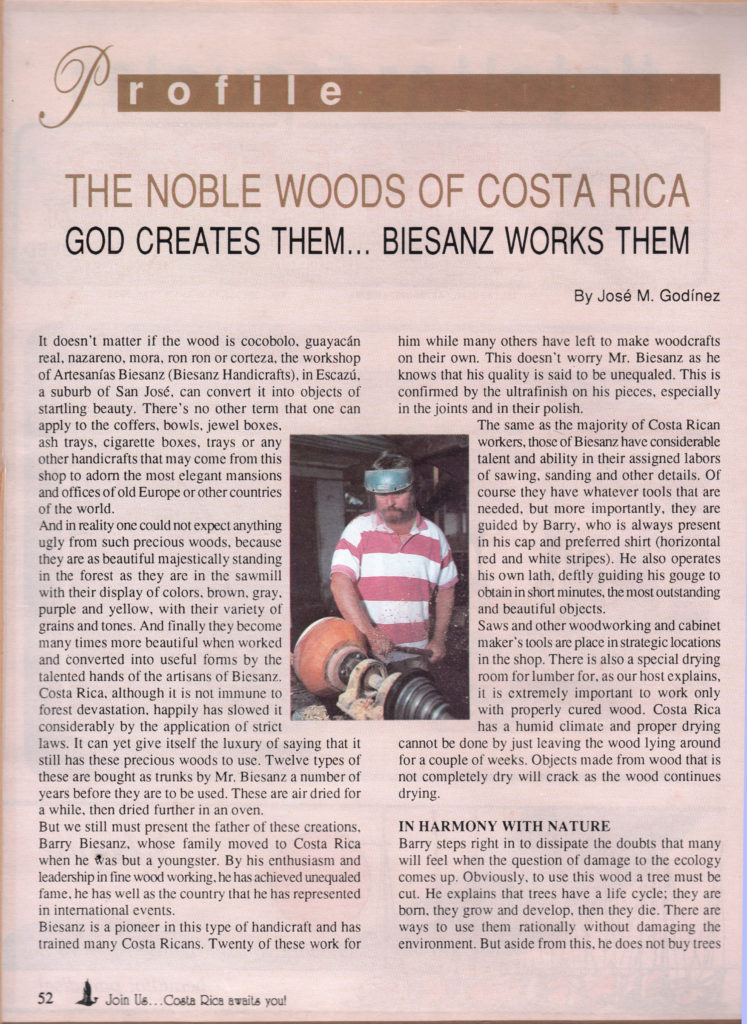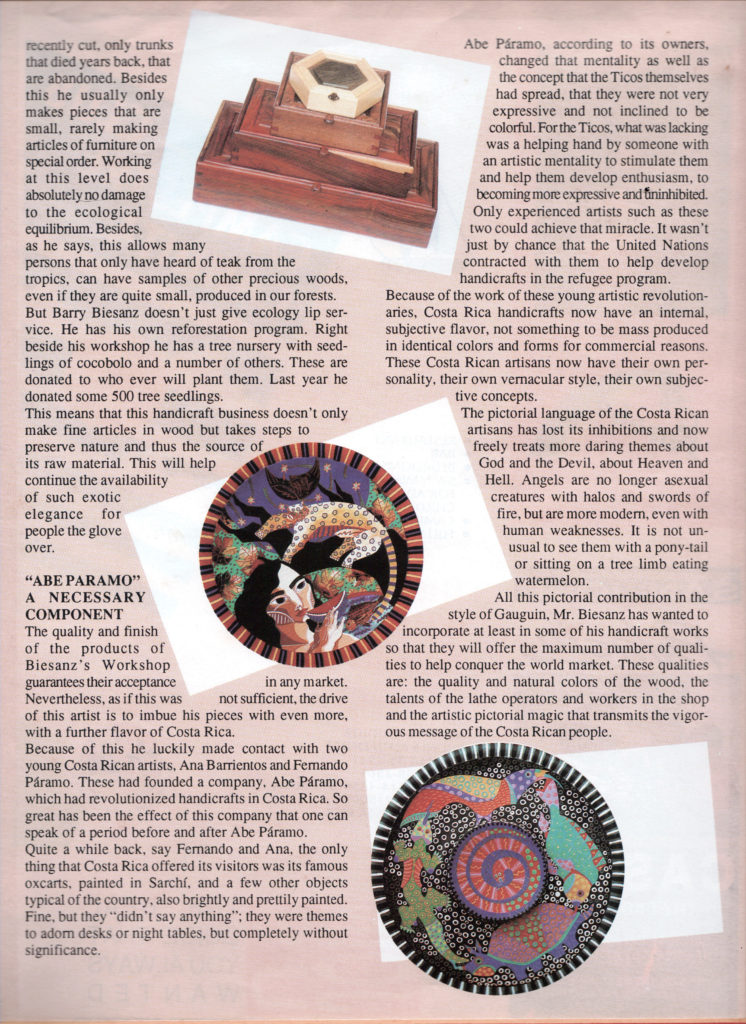Join Us Magazine - God Creates them, Biesanz Works Them


Join Us Magazine – Costa Rica Awaits You! page 52
PROFILE
The Noble Woods of Costa Rica – God Creates Them, Biesanz Works Them
It doesn’t matter if the wood is cocobolo, guayacán real, nazareno, mora, ron ron, or corteza, the workshop of Artesanías Biesanz (Biesanz Handicrafts) in Escazú, a suburb of San José can convert it into objects of startling beauty. There is no other term that one can apply to the coffers, bowls, jewel boxes, ash trays, cigarette boxes, trays, or any other handicrafts that may come from this shop to adorn the most elegant mansions and offices of old Europe and other countries of the world.
And in reality, one could not expect anything ugly from such precious woods, because they are as beautiful majestically standing in the forest as they are in the sawmill with their display of colors, brown, gray, purple and yellow with their variety of grains and tones. And finally they became many times more beautiful when worked and converted into useful forms by the talented hands of the artisans of Biesanz. Costa Rica, although it is not immune to forest devastation, happily has slowed it considerably by the application of strict laws. It can yet give itself the luxury of saying that it still has these precious woods to use. Twelve types of these are bought as logs by Mr. Biesanz a number of years before they are to be used. These are air dried for a while and then dried further in an oven.
But we still must present the father of these creations, Barry Biesanz, whose family moved to Costa Rica when he was but a youngster. By his enthusiasm and leadership in fine woodworking, he has achieved unequalled fame, he has well as the country that he has represented in international events.
Biesanz is a pioneer in this type of handicraft and has trained many Costa Ricans. Twenty of these work for him, while many others have left to make woodcrafts on their own. This doesn’t worry Mr. Biesanz as he knows that his quality is said to be unequalled. This is confirmed by the ultrafinish on his pieces, especially in the joints and in their polish.
The same as the majority of Costa Rican workers, those of Biesanz have considerable talent and ability in their assigned labors of sawing, sanding and other details. Of course they have whatever tools that are needed, but more importantly they are guided by Barry, who is always present in his cap and preferred shirt (horizontal red and white stripes) He also operates his own lathe, deftly guiding his gouge to obtain in short minutes the most outstanding and beautiful objects.
Saws and other woodworking and cabinetmaker’s tools are placed in strategic locations in the shop. There is also a special drying room for lumber, for, as our host explains, it is extremely important to work only with properly cured wood. Costa Rica has a humid climate and proper drying cannot be done by just leaving the wood lying around for a couple of weeks. Objects made from wood that is not completely dry will crack as the wood continues drying.
IN HARMONY WITH NATURE
Barry steps right in to dissipate the doubts that many will feel when the question of damage to the ecology comes up. Obviously, to use this wood, a tree must be cut. He explains that trees have a life cycle; they are born, they grow and develop, and then the die. There are ways to use them rationally without damaging the environment. But aside from this, he does not buy trees recently cut, only trunks recently cut, that are abandoned. Besides this, he usually only makes pieces that are small, rarely making articles of furniture on special order. Working at this level does absolutely no damage to the ecological equilibrium. Besides, as he says, this allows many persons that have only heard of teak from the tropics can have samples of other precious woods, even if they are quite small, produced in our forests.
But Barry Biesanz doesn’t just give ecology lip service. He has his own reforestation program. Right beside his workshop he has a tree nursery with seedlings of cocobolo and a number of others. These are donated to whoever will plant them. Last year he donated some 500 tree seedlings.
This means that this handicraft business doesn’t only make fine articles in wood but takes steps to preserve nature and thus the source of its raw material. This will help continue the availability of such exotic elegance for people the world over.
ABE PARAMO A NECESSARY COMPONENT
The quality and finish of the products of Biesanz Workshop guarantees their acceptance in any market. Nevertheless, as if this was not sufficient the drive of this artist is to imbue his pieces with even more, with a further flavor of Costa Rica.
Because of this he luckily made contact with two young Costa Rican artists, Ana Barrientos and Fernando Páramo. These had founded a company, Abe Páramo which had revolutionized handicrafts in Costa Rica. So great has been the effect of this company that one can speak of a period before and after Abe Páramo. Quite a while back, say Ana and Fernando, the only thing that Costa Rica offered its visitors was its famous oxcarts, painted in Sarchí, and a few other objects typical of the country, also brightly and prettily painted. Fine, but they “didn’t say anything;” they were themes to adorn desks or night tables, but completely without significance.
Abe Páramo, according to its owners, changed that mentality as well as the concept that the Ticos themselves had spread, that they were not very expressive and not inclined to be colorful. For the Ticos, what was lacking was a helping hand by someone with an artistic mentality to stimulate them and help them develop enthusiasm, to become more expressive and uninhibited. Only experienced artists such as these two could achieve that miracle. It wasn’t just by chance that the United Nations contracted them to help develop handicrafts in the refugee program.
Because of the work of these young artistic revolutionaries, Costa Rican handicrafts now have an internal, subjective flavor, not something to be mass produced in identical colors and forms for commercial reasons. These Costa Rican artisans now have their own personality, their own vernacular style, their own subjective concepts.
The pictorial language of the Costa Rican artisans has lost its inhibitions and now freely treats more daring themes about God and the Devil, about Heaven and Hell. Angels are no longer asexual creatures with halos and swords of fire, but are more modern, even with human weaknesses. It is not unusual to see them with a ponytail or sitting on a tree limb eating watermelon.
All this pictorial contribution in the style of Gauguin, Mr. Biesanz has wanted to incorporate at least in some of his handicraft works so that they will offer a maximum number of qualities to help conquer the world market. These qualities are: the quality and natural colors of the wood, the talents of the lathe operators and workers in the shop and the artistic pictorial magic that transmits the vigorous message of the Costa Rican people.
